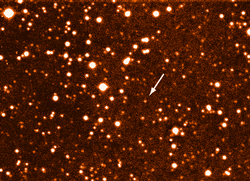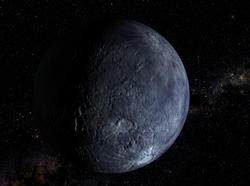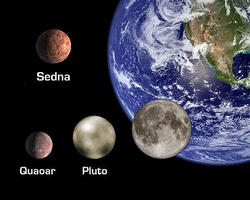Quaoar
The Eleventh Planet
Quaoar is a minor planetary body in our solar syatem and it's orbit is different than the other planets in our solar system. The surface of Quaoar is barren it consists mainly of hard rock and ice there is a light atmosphere around the planet Quaoar but it's not fit for humans. There are no life forms on the surface of Quaoar it is a dead planet and you could say the planet Quaoar is a large rock trapped in the darkness of the Kuiper belt in a orbit around our sun.
If the interior is warm enough, there may be enough energy for the turning over of layers inside Quaoar. This type of interior motion leaves clues on the surface of a planet. (Surface plate tectonics and related earthquakes are big clues about motions within the Earth).
Named Quaoar the object resides in the Kuiper belt, a region of the sky beyond the orbit of Pluto and about 4 billion miles (6.5 billion kilometers) from Earth. The Kuiper belt is chock full of remnants from the planet-formation era of the solar system.
Like the planet Pluto, Quaoar dwells in the Kuiper Belt, an icy debris field of comet-like bodies extending 5 billion kilometers beyond Neptune's orbit. Over the past decade more than 500 icy bodies--Kuiper-Belt Objects or "KBOs" for short--have been found there. With a few exceptions all have been significantly smaller than Pluto.
Quaoar composed primarily of rock and ice, and circles the sun once every 288 years.
Planetary Statistics
Star System : Meridian Solar System
Discovery Status : Confirmed By NASA & Wingmakers
Mass : 1,250 kilometers [777 miles] in diameter."
Average Distance : about 4 billion miles (6.5 billion kilometers)
from Earth in a region beyond the orbit of Pluto known as the Kuiper belt.
Detection Method : the Hubble Space Telescope.
Discovered By : NASA
Year Discovered : 2001
Visited: Wingmakers 2000



